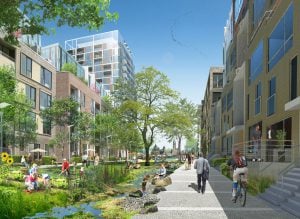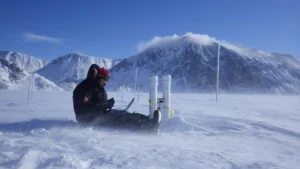
People & Culture
Q&A with Jeff Westeinde on Ottawa’s Zibi project
In the April issue of Canadian Geographic I wrote about Stratford, Ont.'s three decade struggle to repurpose the giant, neglected railway…
- 5118 words
- 21 minutes
This article is over 5 years old and may contain outdated information.
Science & Tech

Food is expensive in the Arctic. Whether you’re gassing up your snowmobile to go seal hunting for your dinner or browsing the shelves at the grocery store — where a cabbage can cost more than $20 — feeding a family well can be challenging. Hunting and fishing are still important, but nowadays Inuit eat more “market food” than ever before. The least nutritious food is also the least expensive, and many Inuit live on low incomes. Heart disease and obesity are rising, while communities struggle with youth suicide and other social problems linked to rapid change.
Ellen Avard, a PhD candidate from Quebec City’s Laval University, is working with the Nunavik community of Kuujjuaq, in northern Quebec, on a project that simultaneously builds food security and community well-being — using greenhouses.
As part of a team of volunteers and local and regional organizations, Avard helped revitalize an existing greenhouse and community garden, and a new greenhouse was built. Using the practical knowledge they gained, she and her team are aiming to develop a new northern food system that works alongside the existing food system, producing high-quality, low-cost fruit and vegetables while teaching people to garden by tending to a variety of crops. The Kuujjuaq greenhouses can grow most vegetables common in southern Canadian community gardens, although tomatoes need to be babied (the buildings aren’t yet heated for cold-weather use).
“People have demonstrated real interest in greenhouse-based food production,” says Avard. “They see it as a way to improve the supply of fresh food — and an opportunity to learn new skills and create jobs. They also see parallels with traditional activities like berry picking.”
A community compost project, the brainchild of Avard and volunteer Marc-André Lamontagne, collects local food waste to make rich soil, which can otherwise be difficult to come by in the North. Operated by Ungava Supervised Apartments, it doubles as a social reintegration project, employing people with disabilities.
“I’m convinced that community agriculture will become part of a new northern food system that provides better, cheaper food and also contributes to socio-economic stability,” says Avard. Others agree. Inspired by Kuujjuaq’s success, the Nunavik communities of Salluit and Kangiqsujuaq are planning their own greenhouse projects.


Are you passionate about Canadian geography?
You can support Canadian Geographic in 3 ways:

People & Culture
In the April issue of Canadian Geographic I wrote about Stratford, Ont.'s three decade struggle to repurpose the giant, neglected railway…

Environment
The uncertainty and change that's currently disrupting the region dominated the annual meeting's agenda

People & Culture
As the climate heats up, so do talks over land ownership in the Arctic. What does Canadian Arctic Sovereignty look like as the ice melts?

Science & Tech
Celebrating Canadian Innovation Week 2023 by spotlighting the people and organizations designing a better future